The 2023 Fundraising Outlook Report: Looking Back, Looking Ahead
Now in its third year, The Fundraising Outlook report from OneCause is based on an annual survey of fundraising professionals to get a pulse on where nonprofits are finding success, what their biggest challenges are, and what they’re prioritizing as they allocate budget and resources for the future.
Since last year’s report, which focused on planning for post-pandemic engagement, nonprofits have faced continued challenges and uncertainty in a turbulent and altered philanthropic landscape.
In The 2023 Fundraising Outlook: Insights for Planning and Prioritization, 890 fundraising pros shared a glimpse into their fundraising successes and challenges from 2022 and their strategies for 2023.
Here are some of the key findings:
- Event and online fundraising revenue remain vital to nonprofit success.
- Donor-related challenges topped the list for most organizations, replacing pandemic planning.
- In-person events will make a strong showing in 2023, and nonprofits remain mindful of donor preferences by keeping virtual and hybrid events on the calendar.
- Organizations have inconsistent access to data useful in data-driven fundraising and storytelling.
- Nonprofits are prioritizing donor acquisition in 2023.
Event and Online Fundraising Revenue Remain Vital
As donors became more comfortable with returning to in-person events in 2022, nonprofits began reallocating their budgets to support a return to the ballroom and live in-person fundraising. Over half of the nonprofits surveyed (56%) reported generating 21% or more of their annual operating revenue (AOR) from their event and online fundraising efforts. Smaller organizations continue to rely most heavily on these types of fundraising: 68% of nonprofits with an AOR below $350,000 and 75% of nonprofits with an AOR of $350,000-$1 million said they raised 21% or more of their budget through event and online fundraising.
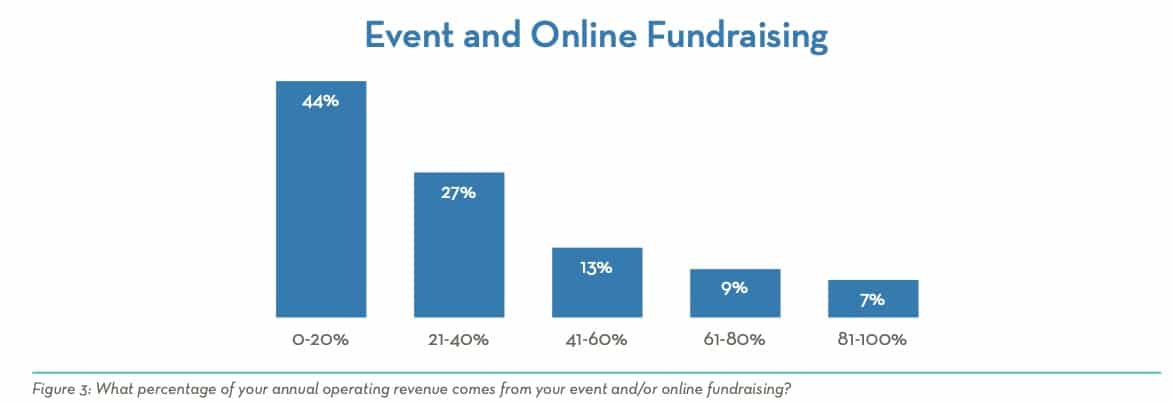
When it comes to how organizations are performing against their 2022 event fundraising goals, 78% of organizations reported being in line with or raising more than their budget. Success is not distributed across the board however! Smaller organizations reported mediocre performance against their budgets at a much higher rate than their larger counterparts. A third (33%) of nonprofits with an AOR below $350,000 and 25% of those with an AOR between $350,000-$1 million said they were raising less than anticipated.
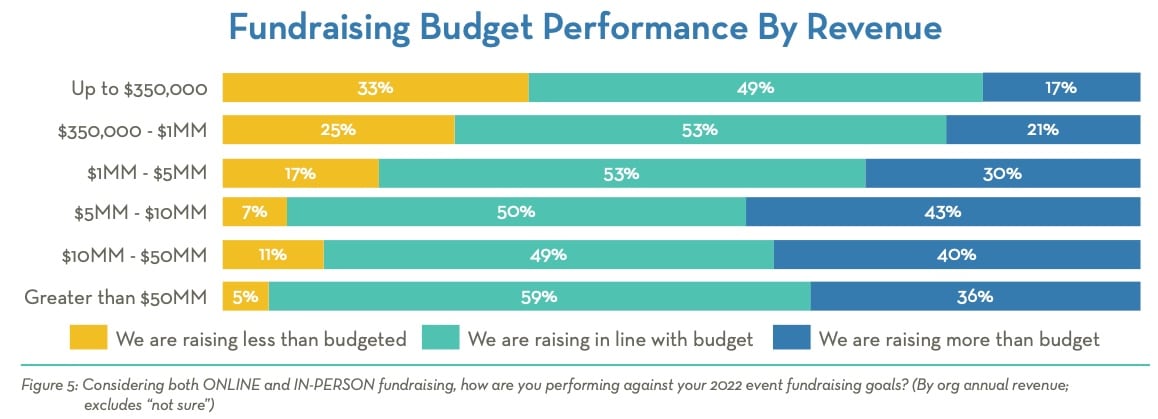
Organizations who employed all in-person or hybrid events to appeal to wider audiences saw much greater success rates than nonprofits who held all virtual events. For nonprofits who held in-person or hybrid events, 80% reported they were in line with or raising more than their budgets, compared to 70% of those who held only virtual events. By type, in-person auction events and golf outings were the strongest performers in 2022.
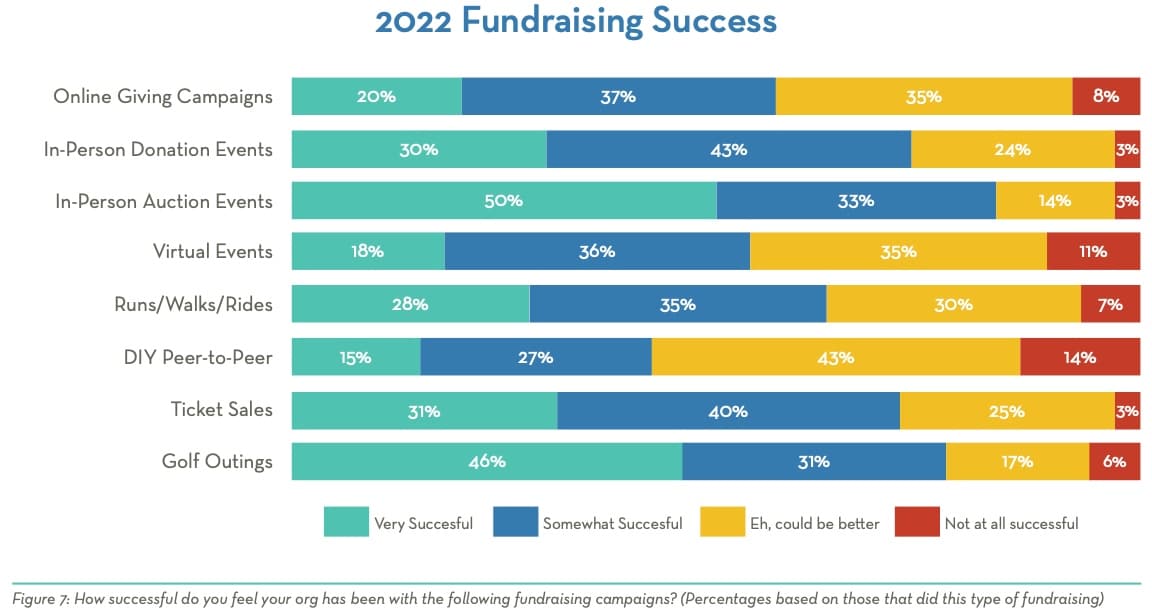
Donor-Related Challenges Topped the List
While still a concern, planning related to the pandemic as a challenge for nonprofits dropped from the number one challenge in 2021 to number ten this year (a 19-point drop). In its place, donor engagement, donor fatigue, recurring giving, and donor retention took top billing.
For many years, nonprofits have worried about donor fatigue. Time and time again, donors have shown that they want to give and will continue to do so when cared for and connected to the cause. Engaged donors rarely become fatigued donors, so it’s important that nonprofits provide a good mix of engagement opportunities for donors and communicate with them according to their preferences.
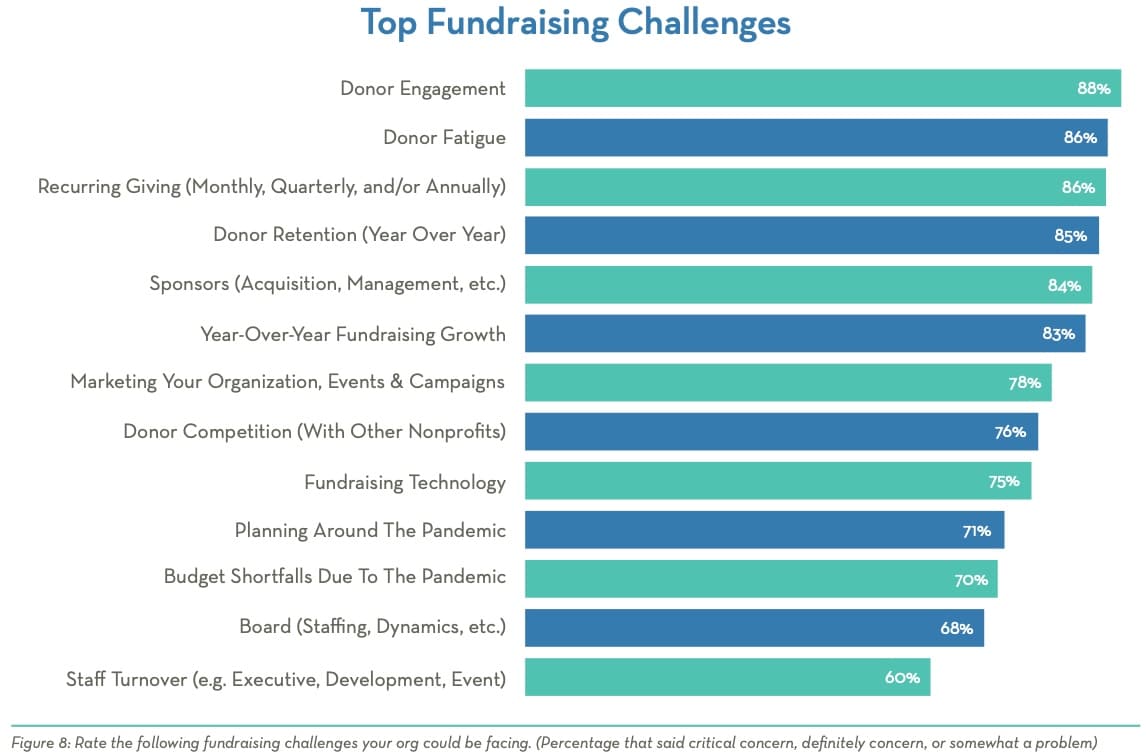
When we viewed challenges at a revenue level and only focused on items nonprofits deemed “critical” or “definitely a concern,” staff turnover appeared in the top 5 challenges for organizations with AORs over $5 million. Many nonprofits were forced to restructure during the pandemic and saw a great deal of turnover. The effects of uncertainty and increased workload on smaller staff can be seen in the data, and there has recently been much attention in the nonprofit world on fundraiser burnout and career changes.
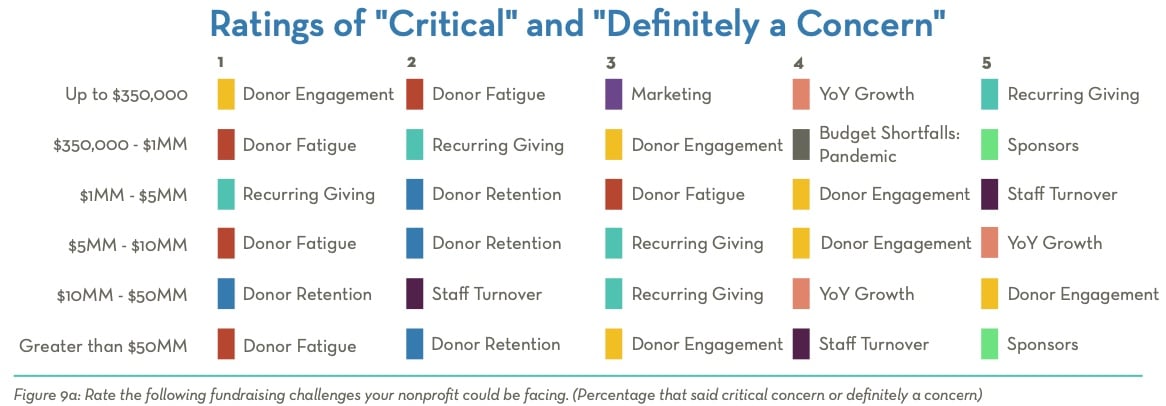
In-person Events Will Make a Strong Showing In 2023
Confidence levels in planning for in-person events saw a huge boost this year, with nonprofits who were undecided about holding in-person events seeing a 12-point drop from 2021. For 2023, 83% of nonprofits say they’ll hold at least one in-person event, which is up 14 points from last year’s report.
It appears nonprofits are taking a cue from their donors by offering virtual elements during events, with nearly half reporting they plan to hold at least one hybrid event in 2023. In the 2022 Giving Experience Study, 56% of event donors said they preferred to have at least some virtual engagement options for events they attend. Planning for virtual-only events in the year to come saw a 7-point drop from 2021’s survey.
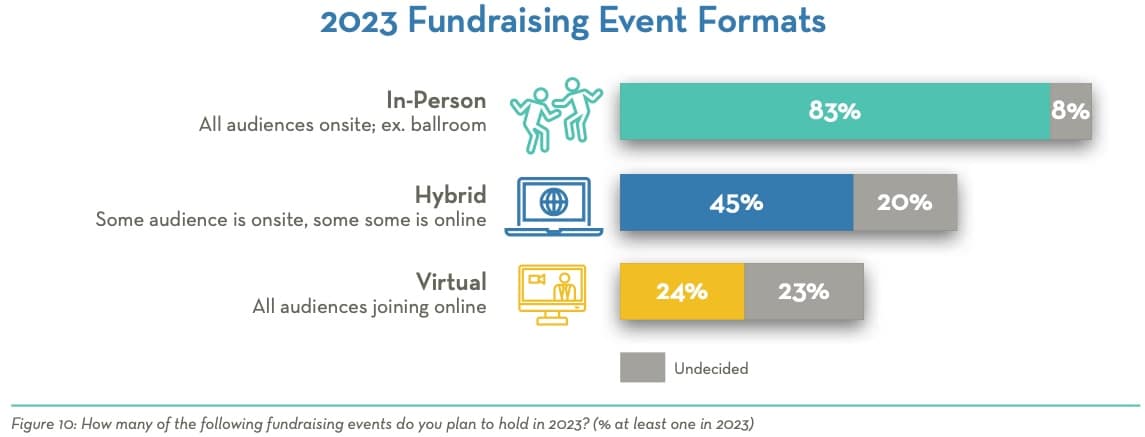
The number of nonprofits planning to increase their budgets for virtual fundraising technology saw a 9-point drop, but 79% of organizations said they would either keep their budget the same or increase it for the virtual fundraising technology necessary to execute hybrid events. This is likely due to a decreased dependence upon having a solution for virtual-only fundraising on a year-round basis.
Organizations Have Inconsistent Access to Data
As nonprofits determine priorities and plan their fundraising strategies for 2023, it’s clear that access to data and the ability to form actionable insights based on fundraising analytics will be a major roadblock for many organizations. Only 18% of nonprofits reported having all the data they need and using it in nearly every decision they make.
Not only is access to data an issue, but the time and ability to analyze and act upon that data are both challenges. Nearly half of nonprofits reported that they have a lot of data, but they either don’t have time to really sit down and analyze it (26%) or they don’t have the necessary training or tools to form actionable insights (22%). Another quarter of nonprofits said they have some data, but that it’s not usable in decision-making due to being disorganized.
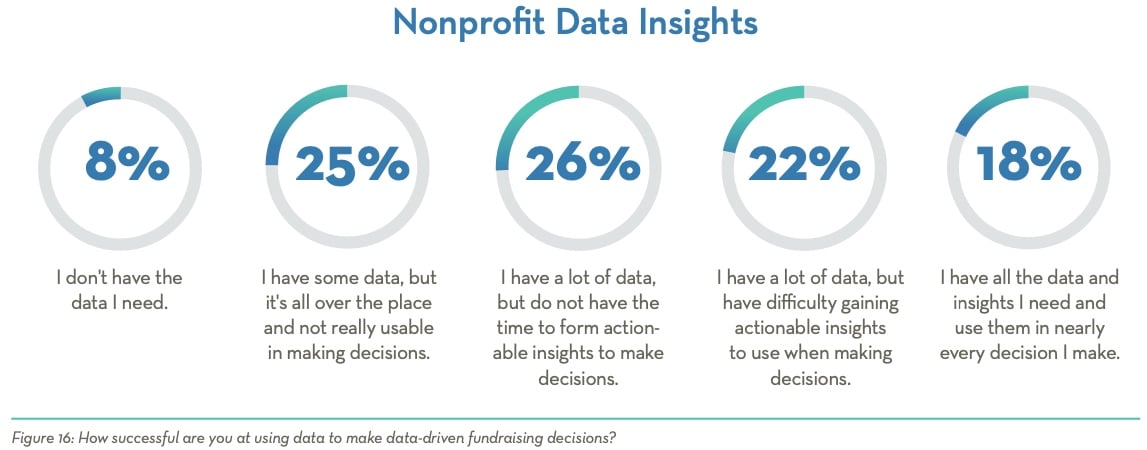
Smaller nonprofits are really feeling the crunch when it comes to data access, with 16% of organizations with AORs below $350,000 saying they don’t have the data they need. Compared to the next highest-reporting group at 5%, that’s quite a disparity.
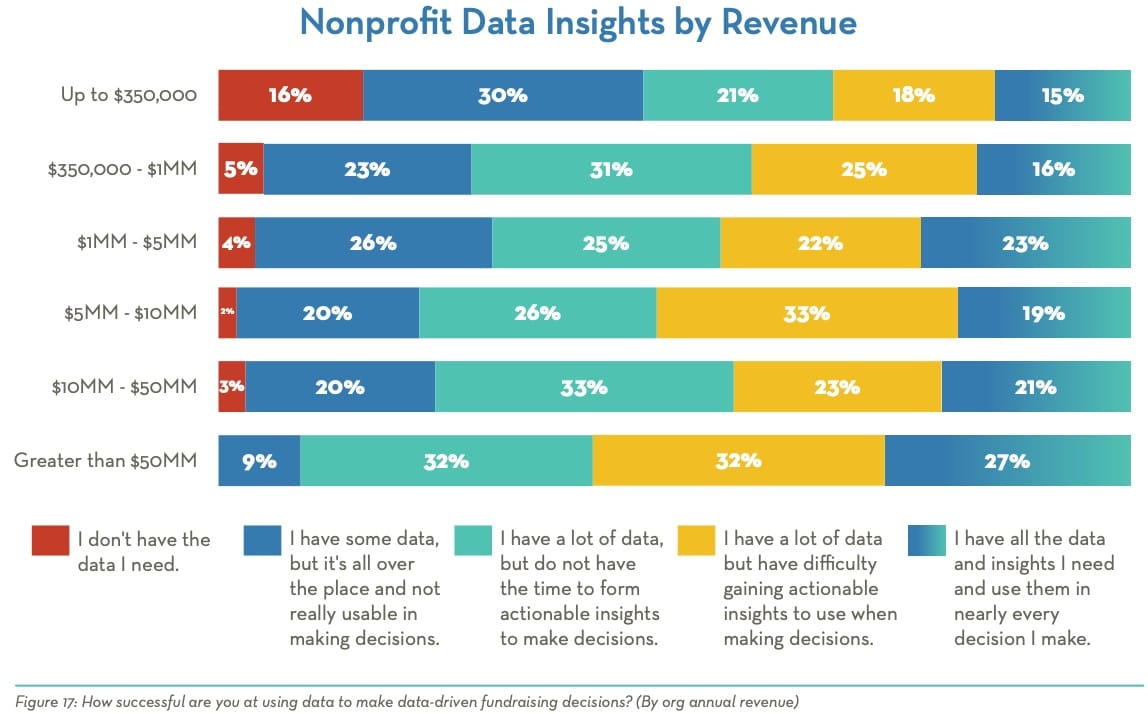
If your organization is grappling with time and resource limitations, it will be important to start small in 2023. The seemingly unlimited number of metrics can be overwhelming, so choosing a small set of data that’s useful to your strategy is a good place to start. For example, if you’re looking to increase recurring giving, start by focusing on recurring-relating metrics. It’s also important to evaluate your tech stack to be sure you’re getting sufficient data analytics and insights, and audit how your organization is using data in fundraising practices across teams and according to roles.
Nonprofits Are Prioritizing Donor Acquisition in 2023
As the frenzied shift to virtual-only fundraising begins to recede in the rearview mirror, most nonprofits anticipate prioritizing growing their donor base in 2023. There will also be an emphasis on strengthening relationships with existing donors and increasing funds raised from existing campaigns. Fewer than half of nonprofits rated operational efficiency and effectiveness or new ways to fundraise as “critical.”
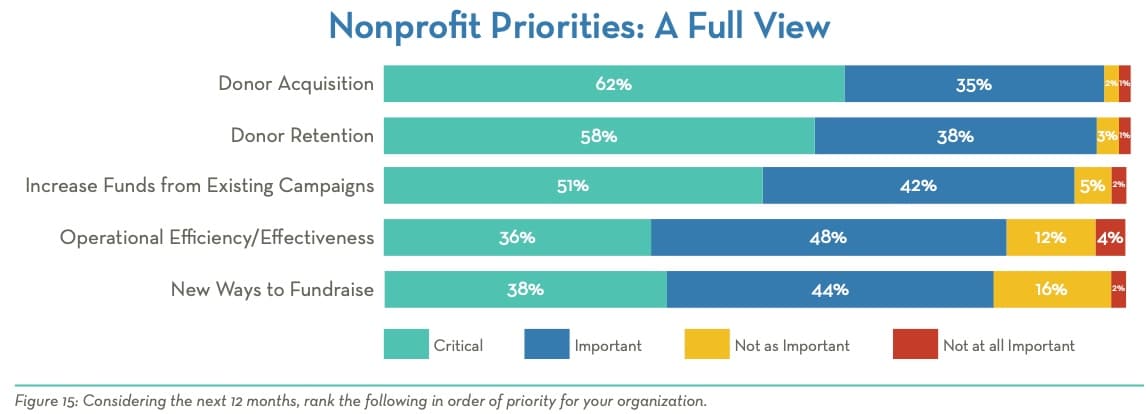
However, we found that social giving has grown 6 points since 2018 and has expanded access — especially through virtual and hybrid programming — to new donor bases. To acquire new donors, organizations who have not typically relied on formats like DIY, hybrid peer-to-peer events, and/or auctions with a virtual component may want to consider experimenting with these wide-reaching formats.
Wrapping Up
How are you planning for the months to come? Here are some tips to get you started:
- Review the input from your peers within The 2023 Fundraising Outlook and use the findings to benchmark your fundraising performance. Download the full report here.
- Remember donor preferences. Take a look at your event calendar. Are you including some virtual elements to appeal to a broader donor base? If not, consider adding a virtual element to one of your in-person events.
- Focus on key data points that will help you achieve your goals. Tackle data difficulties by narrowing in on one or two data sets that will help you achieve success. Looking to boost recurring revenue? Review your database for donors who give multiple times a year but who haven’t yet signed up for a recurring gift. If you can convert ten donors who give $50 three times a year to monthly donors at a rate of $20 per month, that’s a 60% boost in revenue from a small set of donors.
- Review your tech stack. With donor acquisition and retention as top priorities, it’s important to review the technology you’re using to attract and engage people. Your donors interact with you through marketing automation, they’re cultivated according to records kept in your CRM, and they’re either delighted or disappointed based on their experience with your fundraising tools. Ensure you’re using technology that helps you identify and communicate in accordance with their unique preferences, so they experience satisfying interactions at every touchpoint.


